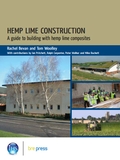Hemp lime construction: A guide to building with hemp lime composites
The Building Research Establishment (BRE) is an independent, research-based consultancy, testing and training organisation, operating in the built environment and associated industries.
On 12 September 2008, BRE published Hemp lime construction: A guide to building with hemp lime composites (EP 85). It was written by Rachel Bevan, principal architect at Rachel Bevan Architects and Tom Woolley, professor of architecture at the Centre for Alternative Technology and chairman of the UK Hemp Lime Construction Products Association. It is the output of a Department for Environment, Food & Rural Affairs (DEFRA) funded study commissioned by the National Non-Food Crops Centre.
Hemp lime is a composite material used for walls, insulation of roofs and floors and as part of timber-framed buildings. It is most commonly a mix of renewably-sourced hemp shiv, a specially-formulated lime binder and water.
Whilst there is a growing awareness of the need to reduce the energy use of buildings in operation, there is still a tendency to construct them from materials that have a high embodied energy, or are in some way damaging to the environment. Hemp lime construction offers a real alternative.
It has good thermal and acoustic performance, and offers a zero-carbon solution for sustainable construction, able to capture and store carbon dioxide in the fabric of buildings. It is light weight, reducing the load on foundations, and so requiring less concrete. Hemp masonry is also breathable, able to absorb and emit moisture, allowing the construction of healthier buildings.
According to BRE’s Hemp Lime, An introduction to low-impact building materials by Andy Sutton, Daniel Black, and Pete Walker:
| It is particularly suited to projects where the design calls for a rendered or rain-screened external finish, good insulation and minimal thermal bridges. It is most commonly used in conjunction with timber frames, but can act as a non-structural walling element for a variety of construction types, including lining masonry walls. |
Hemp lime construction offers 120 pages of comprehensive guidance on the use of hemp lime for housing and low-rise buildings, providing practical information on materials, design and construction. It includes case studies and design details, and explains how the use of hemp-based material can capture and store carbon dioxide in the fabric of buildings.
Its contents are:
- Foreword.
- Introduction.
- What is hemp construction?
- Case examples of hemp lime buildings.
- Growing hemp for building.
- Building construction techniques.
- Mixes and materials.
- Durability, moisture, ventilation, indoor air quality and thermal performance.
- Structures, fire and acoustics.
- Life cycle and carbon sequestration.
- Natural products for use in conjunction with hemp lime.
- The advantages of hemp and lime.
- References and notes.
- Appendices.
- Useful contacts.
- Index.
[edit] Related articles on Designing Buildings Wiki
Featured articles and news
A change to adoptive architecture
Effects of global weather warming on architectural detailing, material choice and human interaction.
How big is the problem and what can we do to mitigate the effects?
Overheating guidance and tools for building designers
A number of cool guides to help with the heat.
The UK's Modern Industrial Strategy: A 10 year plan
Previous consultation criticism, current key elements and general support with some persisting reservations.
Building Safety Regulator reforms
New roles, new staff and a new fast track service pave the way for a single construction regulator.
Architectural Technologist CPDs and Communications
CIAT CPD… and how you can do it!
Cooling centres and cool spaces
Managing extreme heat in cities by directing the public to places for heat stress relief and water sources.
Winter gardens: A brief history and warm variations
Extending the season with glass in different forms and terms.
Restoring Great Yarmouth's Winter Gardens
Transforming one of the least sustainable constructions imaginable.
Construction Skills Mission Board launch sector drive
Newly formed government and industry collaboration set strategy for recruiting an additional 100,000 construction workers a year.
New Architects Code comes into effect in September 2025
ARB Architects Code of Conduct and Practice available with ongoing consultation regarding guidance.
Welsh Skills Body (Medr) launches ambitious plan
The new skills body brings together funding and regulation of tertiary education and research for the devolved nation.
Paul Gandy FCIOB announced as next CIOB President
Former Tilbury Douglas CEO takes helm.
UK Infrastructure: A 10 Year Strategy. In brief with reactions
With the National Infrastructure and Service Transformation Authority (NISTA).
Ebenezer Howard: inventor of the garden city. Book review.
Airtightness Topic Guide BSRIA TG 27/2025
Explaining the basics of airtightness, what it is, why it's important, when it's required and how it's carried out.























